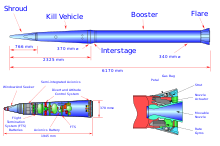Terminal High Altitude Area Defense: Difference between revisions
AnomalousGuy (talk | contribs) No edit summary |
|||
| Line 53: | Line 53: | ||
|guidance= |
|guidance= |
||
|steering= |
|steering= |
||
|accuracy= |
|accuracy=Should be 0m |
||
|launch_platform= |
|launch_platform= |
||
|transport= |
|transport= |
||
Revision as of 13:38, 3 August 2011
| Terminal High Altitude Area Defense (THAAD) | |
|---|---|
 THAAD missile launcher | |
| Type | Anti-ballistic missile system |
| Place of origin | |
| Service history | |
| In service | 2008-present |
| Used by | |
| Production history | |
| Designed | 1987 |
| Manufacturer | Lockheed Martin |
| Produced | 2008-present |
| No. built | 24 Interceptors (First Deployment) |
| Specifications | |
| Mass | 900 kg[1] |
| Length | 6.17 m[1] |
| Diameter | 34 cm[1] |
Operational range | >200 km[1] |
| Maximum speed | 2.8 km/s[1] |
Terminal High Altitude Area Defense (THAAD), formerly Theater High Altitude Area Defense, is a United States Army system to shoot down short, medium, and intermediate ballistic missiles in their terminal phase using a hit-to-kill approach. The missile carries no warhead but relies on the kinetic energy of the impact. THAAD was designed to hit Scuds and similar weapons, but also has a limited capability against ICBMs.
The THAAD system is being designed, built, and integrated by Lockheed Martin Space Systems acting as prime contractor. Key subcontractors include Raytheon, Boeing, Aerojet, Rocketdyne, Honeywell, BAE Systems, and MiltonCAT. Development was budgeted at over USD$700 million for 2004.
Although originally a U.S. Army program, THAAD has come under the umbrella of the Missile Defense Agency. The Navy has a similar program, the sea-based Aegis Ballistic Missile Defense System. THAAD was originally scheduled for deployment in 2012, but deployment has recently been accelerated to 2009.[2]
Development

The THAAD missile defense concept was proposed in 1987, with a formal request for proposals submitted to industry in 1990. In September 1992, the U.S. Army selected Lockheed Martin as prime contractor for THAAD development. Prior to development of a physical prototype, the Aero-Optical Effect (AOE) software code was developed to validate the intended operational profile of Lockheed's proposed design. The first THAAD flight test occurred in April 1995, with all flight tests in the Demonstration-Validation (DEM-VAL) program phase occurring at White Sands Missile Range. The first six intercept attempts missed the target (Flights 4-9). The first successful intercepts were conducted on June 20, 1999, and August 2, 1999, against Hera missiles.
Demonstration-Validation Phase
| Date | Result | Notes |
|---|---|---|
| 21 April 1995 | Success | First test flight to prove the propulsion system. There was no target in the test. |
| 31 July 1995 | Aborted | Kill vehicle control test. The test flight was aborted. There was no target in the test. |
| 13 October 1995 | Success | Launched to test its target-seeking system. There was no attempt to hit the target in the test. |
| 13 December 1995 | Failure | Failed to hit a test target due to software errors in the missile's fuel system. |
| 22 March 1996 | Failure | Failed to hit a test target due to mechanical problems with the kill vehicle's booster separation. |
| 15 July 1996 | Failure | Failed to hit a test target due to a malfunction in the targeting system. |
| 6 March 1997 | Failure | Failed to hit a test target due to a contamination in the electrical system. |
| 12 May 1998 | Failure | Failed to hit a test target due to an electrical short circuit in the booster system. At this point, the U.S. Congress reduced funding for the project due to repeated failures. |
| 29 March 1999 | Failure | Failed to hit a test target due to multiple failures including guidance system. |
| 10 June 1999 | Success | Hit a test target in a simplified test scenario. |
| 2 August 1999 | Success | Hit a test target outside the atmosphere. |
Engineering and manufacturing phase
In June 2000, Lockheed won the Engineering and Manufacturing Development (EMD) contract to turn the design into a mobile tactical army fire unit. Flight tests of this system resumed with missile characterization and full-up system tests in 2006 at White Sands Missile Range, then moved to the Pacific Missile Range Facility.
| Date | Result | Notes |
|---|---|---|
| 22 November 2005 | Success | Launched a missile in its first Flight EMD Test, known as FLT-01. The test was deemed a success by Lockheed and the Pentagon. |
| 11 May 2006 | Success(?) | FLT-02, the first developmental flight test to test the entire system including interceptor, launcher, radar, and fire control system. |
| 12 July 2006 | Success | FLT-03. Intercepted a live target missile. |
| 13 September 2006 | Aborted | HERA target missile launched but had to be terminated in mid-flight before the launch of the FLT-04 missile. This has officially been characterized as a "no test." |
| Fall 2006 | Cancelled | FLT-05, a missile-only test, was postponed until mid-spring 2007. |
| 27 January 2007 | Success | FLT-06. Intercepted a "high endo-atmospheric" (just inside earth’s atmosphere) unitary (non-separating) target representing a "SCUD"-type ballistic missile launched from a mobile platform off Kauai in the Pacific Ocean. |
| 6 April 2007 | Success | FLT-07 test. Intercepted a “mid endo-atmospheric” unitary target missile off Kauai in the Pacific Ocean. It successfully tested THAAD's interoperability with other elements of the MDS system.[3][4] |
| 27 October 2007 | Success | Conducted a successful exo-atmospheric test at the Pacific Missile Range Facility (PMRF) off Kauai, Hawaii. The flight test demonstrated the system's ability to detect, track and intercept an incoming unitary target above the Earth's atmosphere. The Missile was hot-condition tested to prove its ability to operate in extreme environments.[5][6] |
| 27 June 2008 | Success | Downed a missile launched from a C-17 Globemaster III[7] |
| 17 September 2008 | Aborted | Target missile failed shortly after launch so neither interceptor was launched. Officially a "no test".[8] |
| 17 March 2009 | Success | A repeat of the September flight test. This time it was a success[9] |
| 11 December 2009 | Aborted | Target missile failed to ignite after air deployment and the interceptor was not launched. Officially a "no test".[10] |
Production and deployment

Sometimes called Kinetic Kill technology, the THAAD missile destroys missiles by colliding with them, using hit-to-kill technology, like the MIM-104 Patriot PAC-3 (although the PAC-3 also contains a small explosive warhead). This is unlike the Patriot PAC-2 which carried only an explosive warhead detonated using a proximity fuse. Although the actual figures are classified, THAAD missiles have an estimated range of 125 miles (200 km), and can reach an altitude of 93 miles (150 km). The THAAD missile is manufactured at the Lockheed Martin Pike County Operations facility near Troy, Alabama. The facility performs final integration, assembly and testing of the THAAD missile.

The THAAD Radar is an X-Band Radar developed and built by Raytheon at its Andover, Massachusetts Integrated Air Defense Facility. It is the world's largest ground/air-transportable X-Band radar. The THAAD Radar and a variant developed as a forward sensor for ICBM missile defense, the "Forward-Based X-Band - Transportable (FBX-T)" radar were assigned a common designator, AN/TPY-2, in late 2006/early 2007.
First Line Units Activated at Fort Bliss
On 28 May 2008, the U.S. Army activated Alpha Battery, 4th Air Defense Artillery Regiment, 11th Air Defense Artillery Brigade. The Unit is part of the 32nd Army Air & Missile Defense Command. It will have 24 THAAD interceptors, three THAAD launchers based on the M1120 HEMTT Load Handling System, a THAAD Fire Control and a THAAD radar. Full fielding will begin in 2009.[11] [12]
On October 16, 2009, the U.S. Army and the Missile Defense Agency activated the second Terminal High Altitude Area Defense Battery, Alpha Battery, 2nd Air Defense Artillery Regiment, at Fort Bliss, Texas.[13]
Deployment to Hawaii
In June 2009, the United States deployed a THAAD unit to Hawaii, along with a sea-based radar, to defend against a possible North Korean launch targeted at the archipelago.[14]
Possible international users
The United Arab Emirates has requested the purchase a new U.S. missile defense system developed by Lockheed Martin. This deal could be worth $7 billion if approved.[15]
See also
- Arrow missile
- M1120 HEMTT Load Handling System (launcher)
- Advanced Air Defense (AAD)
References
- ^ a b c d e f "THAAD". Webcache.googleusercontent.com. Retrieved 2011-01-24.
- ^ "Pentagon To Accelerate THAAD Deployment", Jeremy Singer, Space News, September 4, 2006
- ^ "MDA's new THAAD success", Martin Sieff, UPI, April 6, 2007
- ^ "Army, Navy and Air Force shoot down test missile", Tom Finnegan, Honolulu Star-Bulletin, Friday, April 6, 2007
- ^ "Press Release by Lockheed Martin on Newswires". Texas: Prnewswire.com. 2007-10-26. Retrieved 2011-01-24.
- ^ "31st successful "hit to kill" intercept in 39 tests". Frontierindia.net. 2007-10-27. Retrieved 2011-01-24.
- ^ "THAAD shoots down missile from C-17 The Associated Press, June 27, 2008
- ^ Defense Test Conducted MDA September 27, 2008
- ^ [1] MDA March 17, 2009
- ^ [2] The Garden Island December 12, 2009
- ^ "First Battery of THAAD Weapon System Activated at Fort Bliss", Lockheed Martin, newsblaze., May 28, 2008
- ^ "First Battery of THAAD Weapon System Activated at Fort Bliss", Press Release , Lockheed Martin Official Website, May 28, 2008
- ^ "Second Battery of Lockheed Martin's THAAD Weapon System Activated at Fort Bliss", Reuters (10-16-2009). Retrieved 10-20-2009.
- ^ Gienger, Viola (2009-06-18). "Gates Orders Measures Against North Korea Missile (Update2)". Bloomberg. Retrieved 2011-01-24.
- ^ "UAE seeks $7 bln Lockheed weapon system", Andrea Shalal-Esa, Reuters UK, May 29, 2008
External links
- Details of the project
- Army Project Page
- MDA Project Page
- Program History
- THAAD Missile description on www.army-technology.com
DEM-VAL Test Program
EMD Test Program
- Successful THAAD Interceptor Launch Achieved, 22 November 2005
- Successful THAAD Integrated System Flight Test, 11 May 2006
- Successful THAAD Intercept Flight, 12 July 2006
- THAAD Equipment Arrives in Hawaii, October 18, 2006
- Successful THAAD "High Endo-Atmospheric" Intercept Test, January 27, 2007
- Successful THAAD Radar Target Tracking Test, March 8, 2007
- Successful THAAD "Mid Endo-Atmopsheric" Intercept, April 6, 2007
- THAAD Radar Supports Successful Aegis BMD Intercept, June 22, 2007
- Successful THAAD Interceptor Low-Altitude "Fly-Out" Test, June 27, 2007

